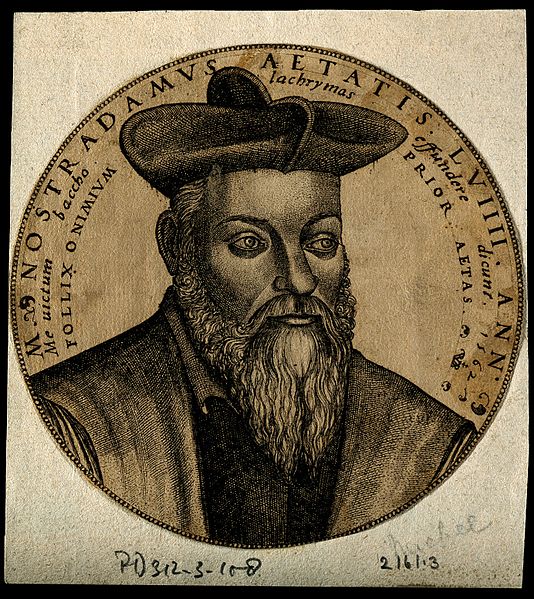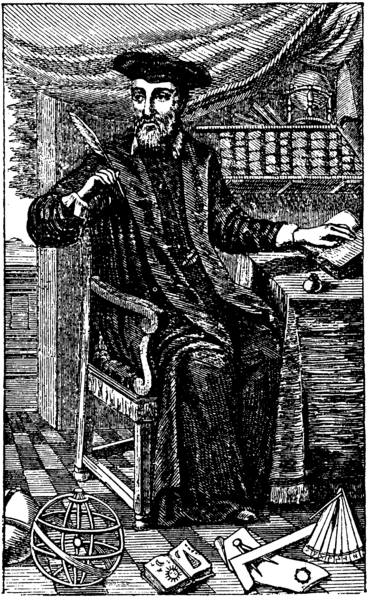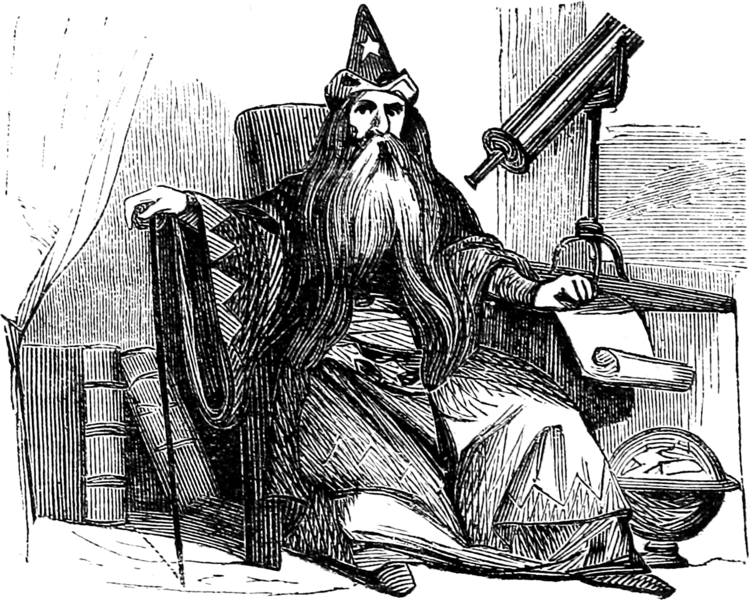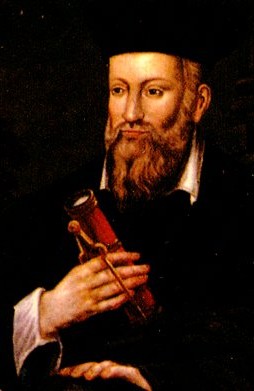From “Les Propheties”, Century nr XIII, Quatraine nr LXXII
Anné dix-nouef la Terre est fatiguée
Un marteau de tenebre comme peste tombera
Des mains du Prince des mille fenetres, argentées
Puis seul et Roi des décombres, il rira, l’homme qui siffle
I hope you did pardon my French. My name is Simon, Simon Whistler [TA1] and that was the quatraine number 72, from ‘Century’ – or chapter – nr 13 of The Prophecies, written in 1555 by the most famous, most quoted and most accurate visionary prophet of modern times. A French doctor, pharmacist, alchemist and practitioner of the occult who in his lifetime would advise Royalty and who after death would never be out of print. He is our protagonist of today: Michel De Nostradame, better known as Nostradamus.

There is little that we know with certainty about his life and exploits, but we will trace his career and look in detail at some of his most famous prophecies. And, as it is fitting for such a mysterious character, there is more to be discovered about Nostradamus and his prophecies, as proven by the recent finding of a Century nr 13 in the old library of his alma mater, the University of Montpellier. A chapter a pparently entirely dedicated to the End of Times, from which we have quoted the early quatrain … but more on this later. For the moment, let’s dive into Nostradamus’ formative years.
Michel de Nostradame was born in Saint-Remy-de-Provence, southern France, either on the 14th or the 21st of December 1503 to parents Reyniere de St-Remy, and her husband Jaume de Nostradame, who worked as a grain dealer and notary.
Michel’s grandfather, Guy Gassonet, was a Jewish doctor and Kabbalist who had converted to Catholicism in 1455 and changed the family name to Nostradame, as a means to avoid discrimination and even persecution by the Inquisition.
We don’t know much about Michel’s childhood, except that he was very bright and that he advanced quickly through school. Both of his grandfathers recognised his potential for learning and dedicated themselves to tutoring him.
His maternal grandfather, Jean de St Remy taught him how to speak and read in Latin, Greek, Hebrew, as well as the rudiments of mathematics. While his paternal grandad, Guy the Kabbalist, introduced him to the more exoteric knowledge of ancient Jewish tradition and the science of astrology. Although this has been disputed, it could explain Nostradame’s interest in applying the study of celestial bodies and how they could influence human destiny.
At the precocious age of 14, Nostradame signed up to the University of Avignon to study medicine. His studies were cut short the following year, however, because of an outbreak of the bubonic plague. This may have been his first encounter with the deadly epidemic, to which he dedicated most of his medical practice in later years
In the following four years young Michel travelled the French countryside researching herbal remedies and working as an apothecary. In 1522, aged 19, he gave it another go at getting a degree, this time entering the University of Montpelier, at that time regarded as one of the best for the teaching of medicine.
The faculty was largely composed of Catholic priests, with whom he clashed often. Apparently they were dismissive or even suspicious of his early astrological knowledge. Let’s not forget that this was a period of great religious tension in the French Kingdom with the Protestant faction of the Huguenots growing in power both in the South and in the Parisian court, causing the Catholic establishment to be suspicious of any ‘heretic’ believer, including those who had Jewish origins.
But what ultimately led to his expulsion from medical school was a more mundane matter: university officials found out about his previous trade as an apothecary, something considered as a lesser ‘manual trade’ and therefore unworthy of that lofty temple of medical studies that was Montpelier. This approach is consistent with views of the time, in fact even surgeons were considered manual labourers and treated as “2nd class citizens” by medical professionals.
But was he actually expelled, though?
After all, surgeons were allowed to attend lectures in Montpelier, even though they had to buy – or even steal – their own corpses if they wanted to practice with their scalpels.[TA2]
And in fact, other accounts state that Michel De Nostradame did complete his medical degree in 1525, the same year in which he changed his name to the Latin ‘Nostradamus’, as was common practice among intellectuals and academics of the time.

But did he actually get a degree, though?
Now, according to other accounts, it was during the years 1521 to 1529 that we travelled the countryside perfecting his herbal remedies and apothecary skills. In those years Nostradamus was aged 18 to 26 years old, the age in which one would normally go to University.
As I mentioned earlier, there is little certainty on Nostradamus’ earlier life. But what it matters is that he did acquire medical knowledge, either through study or through hands-on practice, and that he would use that knowledge against the bane of his contemporaries, the bubonic plague.
Over the end of the 1520s and early 1530s, Nostradamus married and had two children. He was frequently travelling, however, especially around Southern France and Italy, treating victims of the bubonic plague.
There was no known treatment at the time for this infectious disease, but Nostradamus had a stab at developing a healing powder:
‘Take one ounce of the sawdust of cypress-wood, as green as you can find, six ounces of Florentine violet-root, three ounces of cloves, three drams of sweet calamus, and six drams of aloes-wood’
Did it work? We know that violet-root is still used today to treat cough and fevers, so maybe yes. Although … calamus? It is forbidden in the US because of its toxicity! So maybe, not.
But: what Nostradamus did get right were the methods to prevent outbreaks of plague: effective personal hygiene, removal of infected corpses, fresh air. Simple stuff today, but pretty revolutionary for XVI Century Europe.
Thanks to these measures Nostradamus became a local celebrity in the Provence region, in Southern France, even receiving financial support from its citizens. And in 1531, Jules-Cesar Scaliger, a leading physician of his time, became his patron and invited him to work with him in Agen, in southwestern France.
But the plague did not rest. Here is, in Nostradamus’ own words, a vivid description of a common sight at that time
“Among the [most] admirable things I saw, was a woman who, even while I was calling to her through the window, replied to what I was saying while sewing herself unaided into her own shroud, starting with the feet.”
She was later found dead in the middle of the house – “with her sewing half-finished”.
In 1534, Nostradamus’ own wife and children died, presumably of the plague, while he was on a medical mission in Italy. In addition to being a personal tragedy, this was a blow to his own reputation of plague doctor, which caused him to fall out of favour with both the community and his patron, Scaliger.

In the years following the death of his family, Nostradamus started to move away from medicine and towards occult practices, most notably astrology and divination. According to legend – which unfortunately is all we have – in 1538 he was forced to leave France after a brush with the Inquisition. During his travels in Italy he came across a young Franciscan friar called Felice [Fell-ee-tche] in front of whom he immediately knelt down. Years later, the friar was to become Pope Sixtus V. Nostradamus also journeyed across Greece and Turkey, picking up more occult knowledge and experiencing a psychic awakening.
In 1547, he returned to Provence, in the town of Salon, and married a rich widow named Anne Ponsarde. The two would go on to have six children.
It was around this time that Nostradamus really got into what he became most famous for: his predictions. He would bring upon himself a state of trance by meditating for hours in front of a bowl filled with water and herbs, or in front of a mirror. The trance would bring visions, and he would interpret these into predictions.
In 1550, Nostradamus wrote down for the first time these prophecies into an almanac, a popular type of book at that time which included advice for farmers and merchants for the coming year, including astrological predictions. The success of his almanacs, encouraged Nostradamus.
The year 1555 saw the publication of his magnum opus, ‘Les Prophecies’, a collection of predictions divided in Centuries, or chapters, written in the style of four-verse poems, known as quatrains.
These quatrains report Nostradamus’ visions for the following 2000 years and are written in a cryptic style using anagrams, metaphors and an obscure combination of local French dialects, Greek, Latin and Italian. Some of his predictions famously anticipated events such as the great fire of London, the French Revolution, the advent of Napoleon, the rise and fall of Hitler, and the 9/11 attacks.
Here is what Nostradamus wrote about the Fire of London:
“The blood of the just will be lacking in London,
Burnt up in the fire of ’66:
The ancient Lady will topple from her high place,
Many of the same sect will be killed.”
Besides clearly stating the fire of 1666 in London, the doctor also gets another detail right: ‘the blood of the just will be lacking’. Not only the death toll of the fire was relatively low with eight deaths, but the calamity had also the positive effect of burning down millions of infected rats, thus eliminating the outbreak of plague that had ravaged the city in previous years.
Now, for the French revolution:
“Songs, chants, and demands will come from the enslaved
Held captive by the nobility in their prisons
At a later date, brainless idiots
Will take these as divine utterances.”
This one is more open to interpretation, although you find a reference to a rebellion against nobility, a prison which could be the Bastille stormed in 1789, and the rise to power of brainless idiots – possibly the Directorate during the Terror.
Napoleon also gets one:
“Pau, Nay, Loron, more fire than blood,
Swimming in praise, the great man hurries to the confluence.
He will refuse entry to the magpies,
Pampon and Durrance will confine them. “
The first three words are an anagram of Napaulon Roy, which sounds like “Napoleon the King”, who drew his power from military prowess – fire – rather than aristocratic origins – blood. There is also a vague reference to magpies being confined, which has been interpreted to represent Napoleon’s incarceration of Popes Pius VI and VII.
Napoleon wasn’t the only autocratic conqueror to be mentioned in the Propheties. See what you make of this one:
“Beasts ferocious with hunger will cross the rivers,
The greater part of the battlefield will be against Hister.
Into a cage of iron will the great one be drawn,
When the son of Germany obeys no law”
Hister does sound a lot like Hitler, plus you have Germany in there. And you even get a reference to ferocious beasts – soldiers or even tanks? – crossing rivers, in numerical superiority on a battlefield. The great one – being Hitler, again – will be prisoner in a cage of iron, which could be the bunker where he eventually committed suicide.
And finally, Nostradamus’ vision of the 9/11 attacks:
“In the city of God there will be a great thunder
Two brothers torn apart by Chaos while the fortress endures
The great leader will succumb
The third big war will begin when the big city is burning”
Two brothers torn apart: the Twin Towers. The enduring fortress: the Pentagon, which collapsed only partially. And a ‘third big war’ – on Terror – to begin straight after. Could it be any clearer?
Celebrity Status
‘Les Propheties’ has not been out of print since its first publication, but the book that solidified Nostradamus’ celebrity status was the
‘Traité des fardemens et confitures’
This is where he published the plague remedy I mentioned earlier, as well as recipes for candied orange peel and cherry preserve. But the real treat is the ‘love jam’. The ingredients for this concoction included ingredients found in every larder nowadays including cinnamon, cloves, wine, the blood of seven male sparrows and the tentacles of an octopus, preserved in honey. But what was it for?

“If a man were to have a little of it in his mouth, and while having it in his mouth kissed a woman, or a woman him, and expelled it with his saliva, putting some of it in the other’s mouth, it would suddenly cause … a burning of her heart to perform the love-act”
We at Biographics do not endorse this as a method of wooing a lady, preferring to rely only on our charm, wits and looks.
Nostradamus fame grew and he attracted the attention of some VIP admirers, such as Queen Caterina de Medici, wife to King Henri II and real power behind the scenes of French politics.
Nostradamus had hinted at some threats to her family in his almanacs and so the Queen summoned him to court appointing him Counselor and Physician-in-Ordinary to the court. In 1556, while serving in this capacity Nostradamus clarified to her another prophecy from Centuries I, which referred to King Henri.
‘Century 1 Quatrain 35
The young lion will overcome the older one,
On the field of combat in a single battle;
He will pierce his eyes through a golden cage,
Two wounds made one, then he dies a cruel death.’
Despite being warned by Nostradamus to avoid jousting matches, three years later, King Henri then aged 41 years old, faced a younger knight in such a duel. His opponent’s lance pierced the king’s visor – shaped as cage – and entered his brain behind the eye. After 10 agonizing days the King died of sepsis.
Nostradamus the doctor unfortunately did not possess the knowledge to treat the ailment which cursed him for much of his adult life: gout. The condition deteriorated into dropsy, which is an excessive retention of fluids accumulating in body cavities, causing heart failure in its extreme form.
In late June of 1566, Nostradamus called for his lawyer to draft his last will and testament, to the benefit of his wife and children. On the evening of July the 1st, he told his secretary Jean de Chavigny,
“You will not find me alive at sunrise.”
Another accurate prophecy. The morning after Chavigny found Nostradamus lying dead next to his bed.
Nostradamus’ greatest legacy is, of course, his prophetic body of work, which continue to puzzle and fascinate scholars and enthusiasts of the occult worldwide, striving to interpret his more obscure writings.
We at Biographics want to play our part, too, and so we will try to find the hidden meaning behind the recently discovered quatrains which foreshadow an apocalyptic future. Remember the one I read at the beginning? Here is our translation.
From “Les Propheties”, Century nr XIII, Quatraine nr LXXII

Hello again, I hope you are still watching and not too spooked by our little prank, here. Let me reassure you that there are only 12 Centuries published in the Propheties and no other quatrains were discovered in Montpelier. I just wanted to make a point on how easily in recent years the internet has fostered unsubstantiated interpretations of Nostradamus’ predictions, or in some cases even circulated quatrains that were completely made up![TA3]
Take the famous vision of the 9/11, which I read earlier. That prophecy was a total fake, made up by a Canadian website to show how easily the public can be fooled into believing such predictions. Funnily enough, it was copy and pasted across the Web and still believed to be genuine.
But the wild interpretation of Nostradamus’ writing style for sensationalistic effect can be traced back to earlier years. The famous “Hister” quatrain was popularised by the book ‘The Prophecies of Nostradamus’ by Erika Cheetham, published in 1965, but her translation from ancient French into English is either genuinely inaccurate or manipulated on purpose.
The word “Hister” in the XVI century referred to the lower Danube region, not to a person. The French original contains the word “Germain”, which Cheetham translated as “German”. But a more common meaning of the word in French was “first cousin” or “brother”. In fact here is another translation of the same prediction by James Randi, the famous Canadian stage magician and debunker of psychics[TA4] :
“Beasts mad with hunger will swim across rivers,
Most of the army will be against the Lower Danube.
The great one shall be dragged in an iron cage
When the child brother will observe nothing”
Which may refer to any number of engagements during the Thirty Years’ War, or the siege of Vienna by the Ottomans … but as you may expect prophesising about WWII is far more enticing.
To conclude, we don’t want you to doubt all of Nostradamus’ work. Sure, most of his predictions are vague, obscure, impossible to decipher or open to exploitative interpretations. He may have just made everything up just to sell books! However, it is a fact that some of them contain accurate depictions of what was then his future.
Our point is: when it comes to the Occult and to future-telling, watch out for what you may find out there; always question and double-check what the Internet or even reputable authors may try to tell you – and sell you. It is too easy to believe them at face value – especially if they share our charm, wit and looks.



